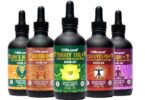The July/August 2009 issue of E – The Environmental Magazine (now posted at: www.emagazine.com) looks at how nanotechnology has changed what we eat, wear and apply to our skin – unfortunately with little regulation and little understanding of the long-term consequences, both to our own health and that of the natural world.
Sunscreens, energy drinks and high-tech clothing are just a few of the 800-plus consumer products made with nanomaterials: those manufactured at the scale of atoms and molecules. Sunscreen that turns clear on the skin contains titanium dioxide, an ordinary UV-blocker in extraordinarily small particles. Odor-eating socks are made with atoms of germ-killing silver. Supplement makers boast of amazing health effects from swallowing nanosolutions that are completely untested for effectiveness or safety.
Nobody — not even the world’s leading nanoscientists — knows what nanoparticles do inside the body or in the environment.
Nanotechnology, a fast-growing global industry, is essentially unregulated. “This is basically virgin territory,” says Rutgers University environmental scientist Paul Lio. “The fact that it’s virgin territory is not good for the field, and it should be fixed really quickly.”
Advocates and independent scientists agree that we need to get ahead of the risks before it’s too late. They are worried about unleashing a powerful new technology that could have vast unintended consequences.
Understanding Nano
Nanotechnology describes the ability to manufacture and manipulate minuscule materials into forms such as quantum dots, spherical buckyballs and cylindrical carbon nanotubes. These engineered nanomaterials take on unusual properties — changing color, for example, or becoming electrically conductive or penetrating cell walls. And they have many uses. Carbon nanotubes, or CNTs — made by rolling up sheets of graphite just one atom thick — are extremely light and strong; they show up in high-end tennis rackets and bicycle frames. Nanosilver is used as an antimicrobial agent in everything from paint to toothpaste to teddy bears. Nanometal oxides are blended into ceramics and coatings, making them more durable.
Nanotech offers enormous potential benefits. Medical researchers are investigating ways to use nanomaterials to target tumors and then deliver tiny amounts of drugs directly inside the cancer cells, sparing the healthy cells. Possible green tech applications include cheaper, more efficient solar panels and water-filtration systems, energy-saving batteries and lighter vehicles that use less fuel.
That’s the upside. But early research on the potential hazards of nanotech is producing major danger signs. Workers handling nanomaterials face the biggest risks. But there are concerns for consumers, too, especially with products — like cosmetics, food and supplements — that go directly on or in the body. And with potentially toxic nanomaterials washing down the drain and into the water and soil, there’s reason to worry about environmental damage as well.
Ignoring the Dangers
Studies on nanotech’s downsides are a mere nanospeck compared to the research that’s being done on how this technology can benefit humanity — and corporate profits. Of $1.5 billion in federal nano spending each year, only between 1% and 2.5% goes toward studying environmental, health and safety risks. Worse, there’s no national strategy for deciding what questions need to be answered, or what to do with those answers as they arrive.
Of the studies that have been done, results are alarming:
Last year, British researchers reported that when long, straight carbon nanotubes — shaped like asbestos fibers — were injected into mice, they caused the same kind of damage as asbestos. A follow-up study this year, by this country’s National Institute for Occupational Safety and Health (NIOSH), found that when mice inhaled CNTs, the tiny tubes migrated from their lungs to the surrounding tissue — the very spot where asbestos causes the rare cancer known as mesothelioma.
One reason nanomaterials can cause trouble is simply that they are small enough to evade the body’s defenses. In a University of Rochester study of the accidental nanoparticles known as ultrafine pollution, they bypassed the protective blood-brain barrier and slipped directly into the brain’s olfactory bulb. Other research demonstrates that nanomaterials can penetrate into the deepest parts of the lungs. From there, they cross into the bloodstream and various organs.
Based on evidence like this, the European Union’s occupational health and safety agency issued an expert report in March, citing nanoparticles as the number-one emerging risk to workers. In the U.S., NIOSH has issued a guidance document urging employers to avoid exposing workers to nanomaterials — for example, by enclosing equipment and using ventilation to reduce dust and fumes. But NIOSH has no regulatory power; it can only suggest.
And concerns continue to grow regarding the ability of nanoparticles to contaminate other people or the environment as they come loose from our sunscreens and clothing. Nanoparticles might also wash down the drain and create dangerously toxic environments for microorganisms — or inhibit good bacteria in sewage treatment plants from doing their work.
“The take-home message for me is, the behavior of these particles is very complex,” says Cyndee Gruden, a civil engineering professor at the University of Toledo in Ohio. “When you take a nanoparticle and put it into the environment, you have to know how it’s going to behave. And we don’t”.
E – The Environmental Magazine distributes 50,000 copies six times per year to subscribers and bookstores. Its website, www.emagazine.com, enjoys 100,000 monthly visitors. E also publishes EarthTalk, a nationally syndicated environmental Q&A column distributed free to 1,750 newspapers, magazines and websites throughout the U.S. and Canada ( www.emagazine.com/earthtalk/thisweek). Single copies of E’s July/August 2009 issue are available for $5 postpaid from: E Magazine, P.O. Box 469111, Escondido, CA 92046. Subscriptions are $29.95 per year, available at the same address.







